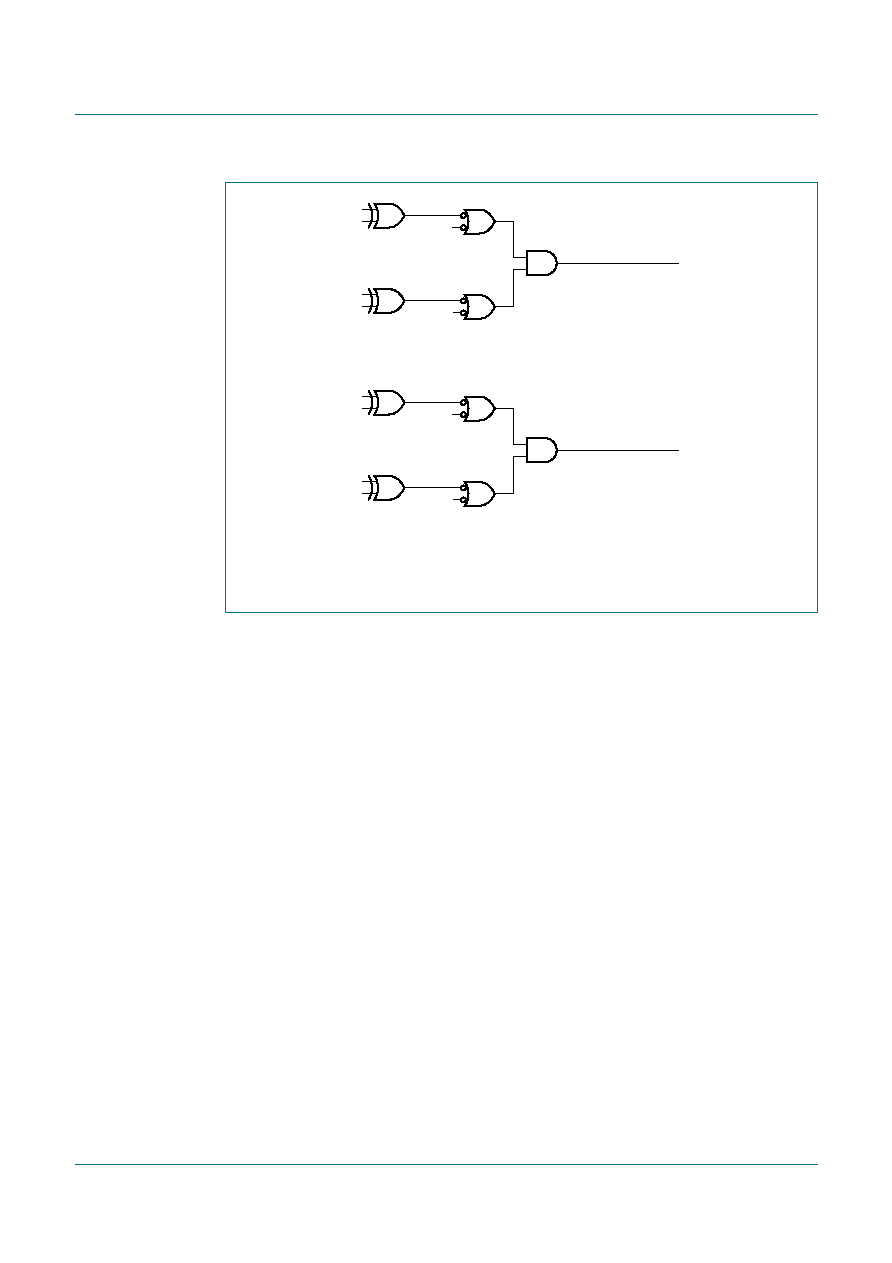- 您现在的位置:买卖IC网 > Sheet目录3841 > PIC18F67K22-I/PTRSL (Microchip Technology)MCU PIC 128K FLASH XLP 64TQFP

P89V52X2_3
NXP B.V. 2009. All rights reserved.
Product data sheet
Rev. 03 — 4 May 2009
29 of 57
NXP Semiconductors
P89V52X2
80C51 with 256 B RAM, 192 B data EEPROM
The following examples will help to show the versatility of this scheme.
Example 1, slave 0:
(4)
Example 2, slave 1:
(5)
In the above example SADDR is the same and the SADEN data is used to differentiate
between the two slaves. Slave 0 requires a ‘0’ in bit 0 and it ignores bit 1. Slave 1 requires
a ‘0’ in bit 1 and bit 0 is ignored. A unique address for Slave 0 would be 1100 0010 since
slave 1 requires a ‘0’ in bit 1. A unique address for slave 1 would be 1100 0001 since a ‘1’
in bit 0 will exclude slave 0. Both slaves can be selected at the same time by an address
which has bit0=0 (for slave 0) and bit1=0 (for slave 1). Thus, both could be addressed
with 1100 0000.
In a more complex system the following could be used to select slaves 1 and 2 while
excluding slave 0:
Example 1, slave 0:
Fig 18. Schemes used by the UART to detect ‘given’ and ‘broadcast’ addresses when
multiprocessor communications is enabled
002aaa527
rx_byte(7)
saddr(7)
saden(7)
rx_byte(0)
saddr(0)
.
given_address_match
logic used by UART to detect 'given address' in received data
saddr(7)
saden(7)
rx_byte(7)
saddr(0)
saden(0)
rx_byte(0)
broadcast_address_match
logic used by UART to detect 'given address' in received data
saden(0)
.
SADDR = 1100 0000
SADEN = 1111 1101
Given = 1100 00X0
----------------------------------------------------
SADDR = 1100 0000
SADEN = 1111 1110
Given = 1100 000X
----------------------------------------------------
发布紧急采购,3分钟左右您将得到回复。
相关PDF资料
PIC18F66K90-I/MRRSL
MCU PIC 64K FLASH MEM XLP 64QFN
PIC16LC621-04/SO
IC MCU OTP 1KX14 COMP 18SOIC
PIC18LF2410-I/SP
IC MCU FLASH 8KX16 28-DIP
DSPIC30F3013-20I/SP
IC DSPIC MCU/DSP 24K 28DIP
PIC18LF6390-I/PT
IC PIC MCU FLASH 4KX16 64TQFP
DSPIC30F3013-30I/SP
IC DSPIC MCU/DSP 24K 28DIP
DSPIC33FJ32MC202-E/SO
IC DSPIC MCU/DSP 32K 28SOIC
52745-0896
CONN FFC 8POS .5MM R/A ZIF SMD
相关代理商/技术参数
PIC18F67K22-I/PTRSL
制造商:Microchip Technology Inc 功能描述:IC 8BIT MCU PIC18F 16MIPS 制造商:Microchip Technology Inc 功能描述:IC, 8BIT MCU, PIC18F, 16MIPS, TQFP-64
PIC18F67K22T-I/MR
功能描述:8位微控制器 -MCU 128kB Flash 4kB RAM
RoHS:否 制造商:Silicon Labs 核心:8051 处理器系列:C8051F39x 数据总线宽度:8 bit 最大时钟频率:50 MHz 程序存储器大小:16 KB 数据 RAM 大小:1 KB 片上 ADC:Yes 工作电源电压:1.8 V to 3.6 V 工作温度范围:- 40 C to + 105 C 封装 / 箱体:QFN-20 安装风格:SMD/SMT
PIC18F67K22T-I/MRRSL
功能描述:8位微控制器 -MCU 128KB Flash 4KB RAM nanoWatt XLP GP RoHS:否 制造商:Silicon Labs 核心:8051 处理器系列:C8051F39x 数据总线宽度:8 bit 最大时钟频率:50 MHz 程序存储器大小:16 KB 数据 RAM 大小:1 KB 片上 ADC:Yes 工作电源电压:1.8 V to 3.6 V 工作温度范围:- 40 C to + 105 C 封装 / 箱体:QFN-20 安装风格:SMD/SMT
PIC18F67K22T-I/PT
功能描述:8位微控制器 -MCU 128kB Flash 4kB RAM
RoHS:否 制造商:Silicon Labs 核心:8051 处理器系列:C8051F39x 数据总线宽度:8 bit 最大时钟频率:50 MHz 程序存储器大小:16 KB 数据 RAM 大小:1 KB 片上 ADC:Yes 工作电源电压:1.8 V to 3.6 V 工作温度范围:- 40 C to + 105 C 封装 / 箱体:QFN-20 安装风格:SMD/SMT
PIC18F67K22T-I/PTRSL
功能描述:8位微控制器 -MCU 128KB Flash 4KB RAM nanoWatt XLP GP RoHS:否 制造商:Silicon Labs 核心:8051 处理器系列:C8051F39x 数据总线宽度:8 bit 最大时钟频率:50 MHz 程序存储器大小:16 KB 数据 RAM 大小:1 KB 片上 ADC:Yes 工作电源电压:1.8 V to 3.6 V 工作温度范围:- 40 C to + 105 C 封装 / 箱体:QFN-20 安装风格:SMD/SMT
PIC18F67K90-E/MR
功能描述:8位微控制器 -MCU 128KB Flash 4KB RAM LCD
RoHS:否 制造商:Silicon Labs 核心:8051 处理器系列:C8051F39x 数据总线宽度:8 bit 最大时钟频率:50 MHz 程序存储器大小:16 KB 数据 RAM 大小:1 KB 片上 ADC:Yes 工作电源电压:1.8 V to 3.6 V 工作温度范围:- 40 C to + 105 C 封装 / 箱体:QFN-20 安装风格:SMD/SMT
PIC18F67K90-E/PT
功能描述:8位微控制器 -MCU 128KB Flash 4KB RAM LCD
RoHS:否 制造商:Silicon Labs 核心:8051 处理器系列:C8051F39x 数据总线宽度:8 bit 最大时钟频率:50 MHz 程序存储器大小:16 KB 数据 RAM 大小:1 KB 片上 ADC:Yes 工作电源电压:1.8 V to 3.6 V 工作温度范围:- 40 C to + 105 C 封装 / 箱体:QFN-20 安装风格:SMD/SMT
PIC18F67K90-I/MR
功能描述:8位微控制器 -MCU 128kB Flash 4kB RAM LCD
RoHS:否 制造商:Silicon Labs 核心:8051 处理器系列:C8051F39x 数据总线宽度:8 bit 最大时钟频率:50 MHz 程序存储器大小:16 KB 数据 RAM 大小:1 KB 片上 ADC:Yes 工作电源电压:1.8 V to 3.6 V 工作温度范围:- 40 C to + 105 C 封装 / 箱体:QFN-20 安装风格:SMD/SMT